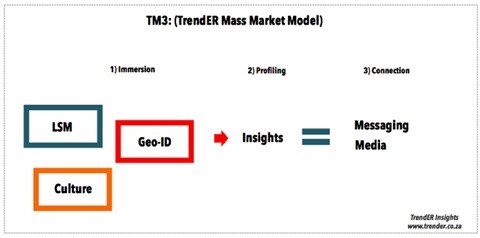We have not had a lot of methodologies that guide us into understanding this market and have therefore relied on Living Standards Measures alone as the basis of our communication.
The "Black market" in its very nature is just a mere classification of race, and it is more complex than we can imagine. It is therefore important to bring all our research and segmentation tools together in a way that will help us dig deeper towards understanding the needs and complexities that lie within thin segment.

The TM3 (Trender Mass Market Model) is a methodology with the objective of looking at different layers that lie within the market to bring a much more in-depth profiling of our target consumer in order to build relevant messaging as well as guide the right media selection and connections to effectively reach our desired audience.
There are three respective stages to the TM3 model:
2) Profiling
3) ConnectionImmersion
Exploration phase were we amalgamate all research to understand their needs behaviours and lifestyle.
LSM - LSM is a good beginning in order to identify the market that you are after. LSMs are the preferred standard of segmentation in marketing and therefore still relevant in identifying whom we want to speak to.
Geo-ID - Black people are one of, if not the most versatile race in South Africa in terms of residential locations. Whether affluent or at the bottom of the pyramid you will find black people living from high end suburbs to the townships.
For example - A domestic worker may live with her family in Sandhust and the type of life her kids are exposed to are far different than that of a family living in the township or rural area.
On the other end, an affluent family may choose to live amongst their family and friends and moving out of the township is not an option for them regardless of their income.
Therefore belonging to specific House Hold Income might not be the right identification of where one lives, especially in the black market.
This is another area of exploration to find out the environment in which our target market lives in; Township or Surburbs, and see what the different lifestyle patterns are within these settings.
Culture - Lastly and most importantly we need to dig deep into their culture. There are different ethnic groups within the South African landscape each with their own beliefs, norms and way of life. We have to be sensitive to the fact that these ethnic groups do things differently even if there might be an overlap in some occasions.
So the next question to ask is are they: Sotho, Zulu, Xhosa and so forth. These need to be explored on their own and not assume that one size fits all.
Example: A lot of marketers have been burned in KZN where they have just taken messaging that worked in Gauteng and applied it in KZN only to find out that it does not hold the same sentiment that it originally had when they put the messaging up in Johannesburg.
There are different rituals, beliefs and systems between ethnic groups and we need to clearly understand each one of them.
With all the learning gathered from the exploration phase, one can now uncover insights that better portray their target markets persona, needs and aspirations.
This will help uncover deep insights about your target consumer that will guide your next step of messaging and media.
You can now build a consumer profile, this is not just a matter of statistics or listing of key take outs and insights, but be able to draft a full profile of the consumer which includes, interests and what they get up to on a daily basis.
One can look at it "as a day in the life" of your consumer.
Here are some guidelines below:
2) Are they married? Do they have a family? How many kids etc.
3) What type of job do they have?
4) What are their favourite TV channels?
5) What do they do in their spare time?
6) Aspirations - where do they see themselves in the future or what are they striving towards?
Connection
The profiling phase would have given you a clear understanding of your target market and now you will be able to conduct your messaging and media.
Looking at your core consumer insight and what their needs are, you are able to match your brand promise to answer to their needs.
Emotive benefits: Build relevance and consideration by communicating how your brand and product fits into their lifestyle.
Functional benefits: Highlight the reasons to believe; what product attributes or benefits will deliver on the rational aspect of your product.
Media: Do not only base this on LSM and race. However use a combination of all the tools from the first phase, which include culture and Geo-ID to guide your media selection.
Remember even though your target market may be of a higher LSM there are still local programs that may air on Free-to-air television which they might watch because of cultural relevance. Therefore do not just skew your media selection sorely based on income, but rather the key take outs and insights from your profiling stemming from the seconds phase.
